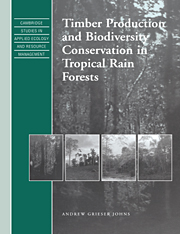Book contents
- Frontmatter
- Contents
- Foreword
- Preface
- Explanatory note
- 1 The issues
- 2 The history and development of tropical forestry
- 3 Changes in the physical environment
- 4 Forest regeneration and gap dynamics
- 5 Responses of individual animal species
- 6 Responses of species assemblages
- 7 Using ecological data in forest management planning
- 8 Intervention to maintain biodiversity
- 9 Field procedures
- 10 The future
- References
- Subject index
8 - Intervention to maintain biodiversity
Published online by Cambridge University Press: 04 December 2009
- Frontmatter
- Contents
- Foreword
- Preface
- Explanatory note
- 1 The issues
- 2 The history and development of tropical forestry
- 3 Changes in the physical environment
- 4 Forest regeneration and gap dynamics
- 5 Responses of individual animal species
- 6 Responses of species assemblages
- 7 Using ecological data in forest management planning
- 8 Intervention to maintain biodiversity
- 9 Field procedures
- 10 The future
- References
- Subject index
Summary
The role of interventions
Primary tropical forests are characterized by a large variation in age structure and usually a high tree species richness, giving a maximum diversification of niches. There are some exceptions, however. Serai stages are more diverse than the climax vegetation in, for example, Queensland rain forests, the Cynometra forests of Uganda and the Gilbertiodendron forests in eastern Zaire.
Managed forests are composed of patches logged at different times and with a high proportion of pioneers or uniformly aged maturing trees corresponding to the time of logging. Managed forests may contain fewer large trees, a lesser abundance of standing or fallen dead wood, and a higher percentage of gaps or building phase vegetation in old gaps.
Principles of island biogeography theory have been used to design management systems for temperate forests which maximize the biological value of the management units. In effect, management attempts to match the spatial heterogeneity of natural forest. These systems revolve around the creation of a mosaic of differently aged forest patches through consecutive cutting of widely separated coupes, and the linking of patches of remnant undisturbed forest by narrow unlogged corridors (Harris 1984). This type of management has been applied fairly successfully in clear-cutting of some temperate forests and subtropical forests of southern Australia (Recher et al. 1987). However, it is often disliked by forest authorities because of the extra cost of creating a permanent road network and becomes redundant where replanting is preferred to natural regeneration (Franklin & Forman 1987).
- Type
- Chapter
- Information
- Publisher: Cambridge University PressPrint publication year: 1997



